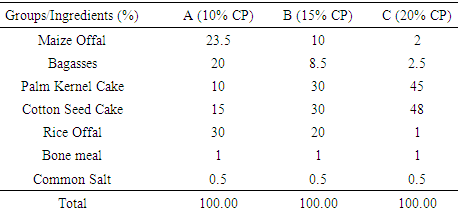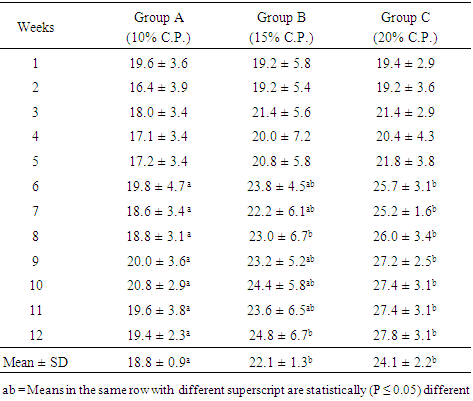-
Paper Information
- Next Paper
- Paper Submission
-
Journal Information
- About This Journal
- Editorial Board
- Current Issue
- Archive
- Author Guidelines
- Contact Us
International Journal of Agriculture and Forestry
p-ISSN: 2165-882X e-ISSN: 2165-8846
2018; 8(1): 1-3
doi:10.5923/j.ijaf.20180801.01

Performance and Scrotal Circumference of Yankasa Rams Fed Graded Levels of Dietary Protein Using Cotton Seed and Palm Kernel Cakes
Bello T. K.1, Rekwot P. I.1, Ayo J. O.2, Oyelowo B. B.3, Hassan R.1, Oke-Egbodo B. E.1, Idris S. Y.4
1National Animal Production Research Institute, Zaria, Nigeria
2Department of Veterinary Physiology, Ahmadu Bello University, Zaria, Nigeria
3Department of Veterinary Pharmacology and Toxicology, Ahmadu Bello University, Zaria, Nigeria
4Department of Veterinary Pathology, Ahmadu Bello University, Zaria, Nigeria
Correspondence to: Bello T. K., National Animal Production Research Institute, Zaria, Nigeria.
| Email: |  |
Copyright © 2018 Scientific & Academic Publishing. All Rights Reserved.
This work is licensed under the Creative Commons Attribution International License (CC BY).
http://creativecommons.org/licenses/by/4.0/

The objective of this study was to assess the effects of graded levels of dietary protein on the live weight changes and scrotal Circumference of Yankasa rams. Fifteen rams were used in this study aged 19.06 ± 2.4 months and weighing 19.4 ±1.6 kg in good body condition scores (3.5). They were divided into three treatment groups (A, B and C) according to the dietary protein levels. Groups A, B and C received 10%, 15% and 20% crude protein levels respectively. All rams were fed basal diet of hay (Digitaria spp) ad-libitum and given a supplement ration of concentrate mixture at 2% body weight/day. Body weights and scrotal circumferences were recorded weekly using weighing scale and flexible measuring tape for 12 weeks. There were significant (P < 0.05) differences in the scrotal circumference increase between groups A and B, A and C respectively. Rams fed 10% crude protein had significantly (P < 0.05) lower mean live weights than those fed 15% and 20% crude protein (CP). Feeding rams 15% CP gave significantly higher values in terms of scrotal circumference than values obtained in rams fed 10%. Although rams fed 20% CP have higher values, there was no significant difference with those fed 15% CP or 20% CP. Therefore, Yankasa rams should preferably be fed crude protein levels of 15% for better live weights and scrotal circumference.
Keywords: Live weights, Scrotal Circumference, Yankasa Rams, Protein
Cite this paper: Bello T. K., Rekwot P. I., Ayo J. O., Oyelowo B. B., Hassan R., Oke-Egbodo B. E., Idris S. Y., Performance and Scrotal Circumference of Yankasa Rams Fed Graded Levels of Dietary Protein Using Cotton Seed and Palm Kernel Cakes, International Journal of Agriculture and Forestry, Vol. 8 No. 1, 2018, pp. 1-3. doi: 10.5923/j.ijaf.20180801.01.
Article Outline
1. Introduction
- There are generally four breeds of sheep native to Nigeria namely, the Balami, Uda, Yankasa and West African Dwarf (WAD) [1]. The relationship between nutrition and reproduction is an increasingly important topic and the interactions have important implications for the reproductive performance of farm animals [2]. The major reason for low levels of animal production in numerous African countries is the inadequate supply and low level of feeding due to serious shortage of feedstuffs [3]. Nutrition plays a major role in enhancing reproductive efficiency in all animals [2]. The fertility of males and females in a particular herd/flock, as well as level of nutrition to a large extent, determines the rate of production in any livestock industry [4]. Dietary protein that contains important amino acids is essential for vital productive and reproductive processes. Basically, protein is a critical nutrient that plays a vital role in livestock production and reproduction, which include body building (growth) and repair of body tissues, synthesis of hormones, nucleoproteins, enzymes and antibodies. The protein used in diets of livestock originates from variety of sources, such as cereal, legumes, forages, animal meals and various by-products [5]. Groundnut cake and soybean meal are the conventional sources of protein in livestock production but expensive to small scale and rural farmers [5]. Some protein sources like cotton seed cake and whole cotton seed though cheaper to obtain, but again are known to contain gossypol, which can significantly have negative effects on semen quality of Yankasa rams if fed above 46% [6]. Though, [7] reported marked severe reductions in testicular sperm reserve, and daily sperm production per gram of testis in rabbit bucks fed cotton seed cake. But overall increased protein intake has been reported to favour spermatogenesis in livestock [8]. The objectives of this study was to assess the effects of graded levels of dietary protein on the live weight changes and scrotal Circumference of Yankasa rams.
2. Materials and Methods
- Body weights of individual ram was taken using a weighing scale. The scrotal circumference was measured with a flexible tape at the broadest part of the scrotum. These parameters were taken on a weekly basis throughout the study period.
|
|
3. Data Analysis
- Data collected were expressed as means and standard error of the mean (SEM). Significance of differences between treatments means were estimated at P ≤ 0.05 using Tukey-Kramer multiple comparison test of repeated measure of analysis of variance.
4. Results
|
|
5. Discussion
- The levels of protein in diets appeared to influence scrotal circumferences (SC) of rams since rams fed 15% CP had significantly higher SC than those on 10% crude protein and these findings agree with that of [9] who reported that, bulls on high protein diets of 14.45% had higher SC than those on 8.15% CP. These results could be attributed to optimum utilization of dietary protein by the rams at 15% inclusion levels. However, the findings disagree with that of [8], who reported a higher SC for rams fed 12.11% CP level. This difference may be due to differences in protein source used, since they used dried layer litter. Similarly, the findings also agree with [10], who reported that, there is a positive correlation between scrotal measurements and body weights. From this study, rams fed 10% CP had the lowest live weights (kg) than those on 15% and 20% CP. This could be explained by the reduced feed intake by rams fed 10% CP, resulting in lower metabolism and subsequent decrease in live weights. This result is contradicted that obtained by [11] where rams fed 12.11% CP had the highest live weight. This difference could be explained by the type of ingredients used as protein source. The authors used dried layer litter, and stated that these animals utilize non protein nitrogen at lower levels than at higher levels. The findings in this study is similar to those reported by [12] and [13], where bulls and rams fed higher protein diets had significant increase in live-weight when compared to those on low protein diet. The lack of significant increase in live weights between rams fed 15% and 20% CP in this present study could be because of production of high level of ammonia associated with high rumen digestible protein and nitrogen retention [11].
6. Conclusions
- From this study, it could be concluded that; Yankasa Rams fed diets containing 15 % CP (cotton seed cake and palm kernel cake) had better results in terms of body weight, scrotal circumference, than feeding rams diets containing 10% C.P. Rams fed 20 % CP also gave better results as regards body weights and scrotal circumferences than rams fed 10% CP. There were no significant differences between rams fed 15% and 20% CP.
7. Recommendations
- Yankasa rams should be fed crude protein levels of 15 %. Further studies should be conducted to investigate if antioxidants could ameliorate some of the negative effects of low and high levels of protein that were observed in this study.
 Abstract
Abstract Reference
Reference Full-Text PDF
Full-Text PDF Full-text HTML
Full-text HTML


